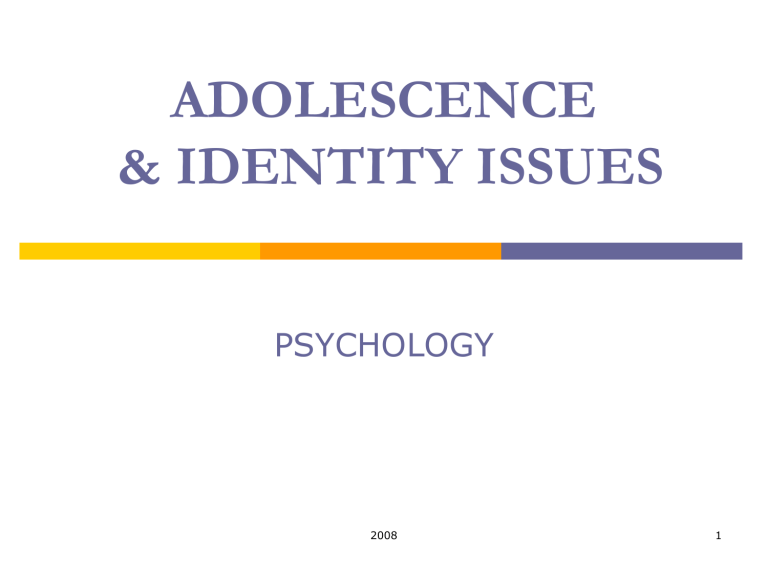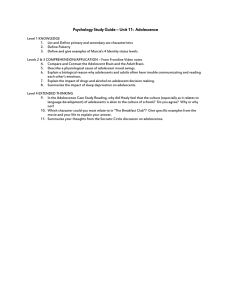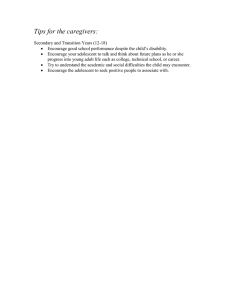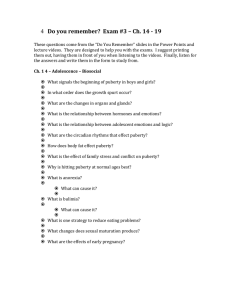
ADOLESCENCE & IDENTITY ISSUES PSYCHOLOGY 2008 1 ADOLESCENCE Adolescence is the period of psychological and social transition between childhood and adulthood. Adolescence is the transitional stage of human development in which a juvenile matures into an adult. 2008 2 ADOLESCENCE This involves biological, social, and psychological changes. Is the time when our bodies, our families, our schools and the larger society demand that we change 2008 3 ADOLESCENCE Adolescence is a modern cultural and social phenomenon. The ages of adolescence vary by culture. The time is identified with dramatic changes in the body along with 2008 4 ADOLESCENCE – Contd. development in a person’s psychology and academic career. A person between early childhood and the teenage years is sometimes referred to as a pre-teen. 2008 5 PUBERTY - Definition “Biological changes of adolescence” Puberty begins when the hypothalamus is signalled and the pituitary gland is activated. There are five physical occurrences from puberty (Marshall, 1978)Steinberg 1996) 2008 6 PUBERTY - CHANGES 1. 2. 3. 4. 5. Body growth occurs Body composition begins to change Circulatory & Respiratory systems begin to change. The primary sex characteristics develop The secondary sex characteristics develop. (See Appendix A) 2008 7 ONSET OF PUBERTY 1. 2. 3. 4. 5. Historically (100 years ago) this stage of development began much later, 14- 18yrs. Western countries age fell, may be due to: Improved nutrition Increased caloric intake Increased artificial hormones in meat Preservatives and chemicals in processing of foods Decreased melatonin levels due to increased exposure to artificial lights (nightlights, tv, computers.) 2008 8 ADOLESCENTS NUTRITION & DEVELOPMENT Nutrition has a great influence on the growth process. Growth develops at an accelerated rate. Type of food consumed crucial to biological and intellectual development. Inadequate died disrupts normal growth and pubertal development. 2008 9 ADOLESCENT FRIENDSHIP CONTEXT OF SOCIAL CHANGE An increase in autonomy and an increase in emotional distance from parents. Friendships – loyalty, Intimacy and personal preference. Other Similarities are in friends 2008 10 ADOLESCENT PEER GROUPS CONTEXT OF SOCIAL CHANGE A peer group is conceived as a small group of similarly aged, fairly close friends, sharing the same activities Spend more time with peers than family or other adults. 2008 11 ADOLESCENT PEER GROUPS CONTEXT OF SOCIAL CHANGE The role played by peers is critical in development prototypes for: adult relationships in social relationships in work or with members of opposite sex. 2008 12 ADOLESCENT PEER GROUPS CONTEXT OF SOCIAL CHANGE In a peer group have the opportunity to learn how to interact with others Have support in defining identity, interests, abilities and personality. Autonomy without the control of adults and parents. 2008 13 ADOLESCENT PEER GROUPS CONTEXT OF SOCIAL CHANGE In a group the adolescent shows signs of autonomy, being a separate person. Cognitive change: can see situation from another person’s point of view. Capacity now to enter close relationships or with peer groups. 2008 14 ADOLESCENT PARENT-CONFLICT Conflicts arise between the adolescent and parents. The level of conflict differs from family to family Due to changing characteristics of Growing adolescent and How family adjust to these changes, for example usually common daily events. 2008 15 ADOLESCENT PARENT- MAJOR CONFLICT Anger is the major emotion associated with conflict. This is accompanied by anxiety, frustration, or guilt. May have problems with sexuality, drugs, alcohol, depression, eating disorders, body image. 2008 16 ADOLESCENT PARENT- MAJOR CONFLICT Also the family situation may add to adolesence problems, such as: Parents being inconsistent with the adolescent Marital conflict or divorce taking place Adjusting to a new step family (Steinberg & Belsky 1991) 2008 17 ADOLESCENTS WHAT IS SELF-ESTEEM “Self esteem is confidence in one’s ability to think and to cope with the challenges of life and confidence in one’s right to be happy (1993) It is defined as a central component of personality and identity. A positive relationship with parents is important to developing a healthy self esteem. 2008 18 ADOLESCENTS CHANGE IN SELF-ESTEEM 1. 2. 3. It is common for self-esteem to temporarily decline in early adolescence though not inevitable. Maybe due to:Due to adolescent confronting experiences about their: Intellectual qualities Popularity, social skills and attractiveness Confronting biological changes-sexuality 2008 19 ADOLESCENCE SELF-ESTEEM & BODY IMAGE BODY IMAGE Definition: “The picture of our own body which we form in our mind. In other words, the way in which the body appears to ourselves.” How does body image develop? How does it affect self-esteem? Characteristics of poor body image? See Appendix B. 2008 20 BIBLIOGRAPHY Santrock, J. (2004). Life Span Development. New York: McGraw Hill Smith, Cowie & Blades (1998) Understanding Children’s Development (3rd ed.) Massachusetts, USA: Blackwell Publishers Inc. Snowman, J. Biehler, R. (2000) Psychology Applied to Teaching (9th Ed.) Boston: Houghton Mifflin Co. 2008 21





